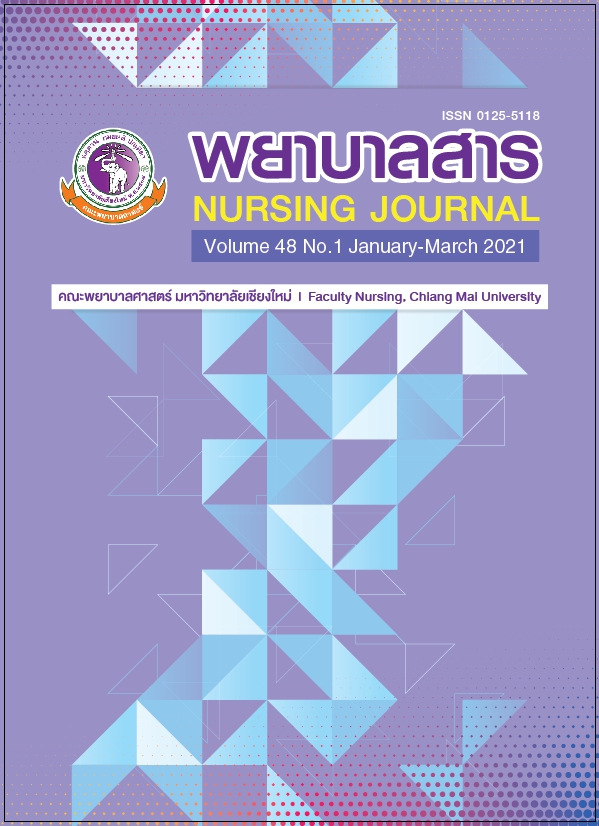Effects of a Self-Management Education Program on Self-Management Behaviors Among Older Persons with Atrial Fibrillation
Keywords:
Self-Management Education Program, Older Persons with Atrial FibrillationAbstract
Atrial fibrillation is a common chronic illness in older persons. Self-management can help patient control the disease. This two group pretest-posttest experimental research aimed to study the effect of self-management education program on self-management behaviors among older persons with atrial fibrillation attending the medical clinic in the outpatient department at Phrae Hospital from November 2015-to April 2016. The subjects were purposively selected based on the inclusion criteria and were randomly assigned into experimental and control groups by using permuted block design with thirty older persons in each group. The subjects in the experimental group received a 6-week self-management education program, while the control group received routine nursing care. The research instruments consisted of the Self-Management Education Program, and the Self-Management Behavior Handbook of the Older Persons with Atrial Fibrillation. The instruments used for data collection consisted of Demographic Data Recording Form, and Self- Management Behaviors Scale for Older Persons with Atrial Fibrillation. Data were analyzed using descriptive statistics and the t-test.
The results of this study indicate that
- After attending the Self-Management Education Program, the older persons with atrial fibrillation had significantly better self-management behaviors than before attending the program at level of p < .001
- Older persons with atrial fibrillation who attended the Self- Management Education Program had significantly better self-management behaviors than that of the group who received the usual care at a level of p < .001.
The results of this study indicated that a Self-Management Education Program can increase self-management behaviors among older persons with atrial fibrillation. Nurses should adopt this program to promote the self-management behavior of older persons.
References
Supporting Program on Self-management Behaviors and Hemoglobin A1C Level among Elders with Diabetes Type 2. Nursing Journal, 39(3), 93-104. (In Thai)
Davis, R. C., Hobbs, F. R., Kenkre, J. E., Roalfe, A. K., Iles, R., Lip, G. Y., & Davies, M. K.
(2012). Prevalence of atrial fibrillation in the general population and in high- risk groups: the ECHOES study. europace, 14(11), 1553-1559
Gage, B. F., Birman-Deych, E., Kerzner, R., Radford, M. J., Nilasena, D. S., & Rich, M. W.
(2005). Incidence of intracranial hemorrhage in patients with atrial fibrillation who are
prone to fall. The American journal of medicine, 118(6), 612-617.
Hansen, M. L., Sørensen, R., Clausen, M. T., Fog-Petersen, M. L., Raunsø, J., Gadsbøll, N., ... &
Torp-Pedersen, C. (2010). Risk of bleeding with single, dual, or triple therapy with
warfarin, aspirin, and clopidogrel in patients with atrial fibrillation. Archives of internal
medicine, 170(16), 1433-1441.
Henkaew, W., Thatsaeng, B., kitisri, M., & Wiyasri, C., (2017). Effects of a Self-Management
Supporting Program on Self-Management Behaviors and Blood Pressure among Older
Adults with Hypertension. Nursing Journal, 44(special (2)), 60-70. (In Thai)
Khan, T. I., Kamali, F., Kesteven, P., Avery, P., & Wynne, H. (2004). The value of education and
selfmonitoring in the management of warfarin therapy in older patients with unstable
control of anticoagulation. British journal of haematology, 126(4), 557-564.
Koponen, L., Rekola, L., Ruotsalainen, T., Lehto, M., Leino Kilpi, H., & Voipio Pulkki, L. M.
(2008). Patient knowledge of atrial fibrillation: 3 month follow up after an emergency
room visit. Journal of advanced nursing, 61(1), 51-61.
Lorig, K. R., & Holman, H. R. (2003). Self-management education: history, definition, outcomes, and mechanisms. Journals of behavioral medicine, 26(1), 1-7.
Go, A. S., Hylek, E. M., Phillips, K. A., Chang, Y., Henault, L. E., Selby, J. V., & Singer, D. E. (2001). Prevalence of diagnosed atrial fibrillation in adults: national implications for rhythm management and stroke prevention: the Anticoagulation and Risk Factors in Atrial Fibrillation (ATRIA) Study. journal of the american medical association, 285(18), 2370.
Phomtaensut, P., Moolsart, S., & Heebthamai. D. (2018). Effectiveness of a pain management and environmental adjustment program for elderly with knee osteoarthritis. Thai Journal of Nursing, 67(4), 34-43.
Phrommintikul, A., Detnuntarat, P., Prasertwitayakij, N., & Wongcharoen, W. (2016). Prevalence of atrial fibrillation in Thai elderly. Journal of geriatric cardiology: JGC, 13(3), 270.
Thatsaeng, B. (2554). Effects of a self-managment supporting program on self-management
behaviors and blood pressure among elders with hypertension. Nursing journal, 39(4),
124-137. (In Thai)
Taggar, J. S., Marín, F., & Lip, G. Y. (2008). Mortality in patients with atrial fibrillation: improving or
not?. Europace, 10, 389-390.
Tiansarr, J., Kanogsunthorntrat, N., & Kitiyakara. C. (2018). Effects of Counseling and
Educational Program based on Motivational Interviewing on Health Behaviors and Clinical Outcomes in Patient with Pre-dialysis Chronic Kidney Disease. Thai Journal of Nursing and Midwifery Practice, 5(2), 19-38. (In Thai)
Vatanasin, S. (2549). Atrial fibrillation Basic dysrhythmias.Bangkok: P. press co., ltd., page
59-84. (In Thai)
Srisomthrong, K., Chintanawat, R., & Sucamvang K. (2017). Self-Management Supporting Programme and Its Impact on Foot-Care Behaviour of Elderly Type-2 Diabetes Patients. Thai Journal of Nursing Council, 32(3), 120-134. (In Thai)
Sanghuachang, W. (2013). Effects of education program using group process and telephone
Follow upon stroke prevention knowledge and practice in elderly with chronic
illness. The Journal of Prapokklao Hospital Clinical Medical Education Center, 30(4),
260-273. (In Thai)
Stewart, S., Murphy, N., Walker, A., McGuire, A., & McMurray, J. J. V.(2004). Cost of an emerging epidemic: an economic analysis of atrial fibrillation in the UK. Heart, 90(3), 286-292.
Wattigney, W. A., Mensah, G. A., & Croft, J. B. (2002). Increased atrial fibrillation mortality:
United States, 1980–1998. American journal of epidemiology, 155(9), 819-826.
Wattigney, W. A., Mensah, G. A., & Croft, J. B. (2003). Increasing trends in hospitalization for
atrial fibrillation in the United States, 1985 through 1999: implications for primary
prevention. Circulation, 108(6), 711-716.
Downloads
Published
How to Cite
Issue
Section
License
บทความที่ได้รับการตีพิมพ์เป็นลิขสิทธิ์ของวารสารพยาบาลสาร
ข้อความที่ปรากฏในบทความแต่ละเรื่องในวารสารวิชาการเล่มนี้เป็นความคิดเห็นส่วนตัวของผู้เขียนแต่ละท่านไม่เกี่ยวข้องกับมหาวิทยาลัยเชียงใหม่ และคณาจารย์ท่านอื่นๆในมหาวิทยาลัยฯ แต่อย่างใด ความรับผิดชอบองค์ประกอบทั้งหมดของบทความแต่ละเรื่องเป็นของผู้เขียนแต่ละท่าน หากมีความผิดพลาดใด ๆ ผู้เขียนแต่ละท่านจะรับผิดชอบบทความของตนเองแต่ผู้เดียว






